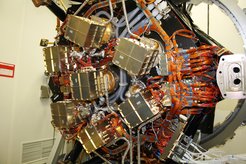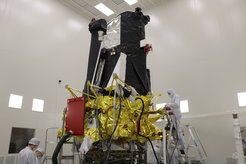eROSITA launch heralds new era for X-ray astronomy
MPE telescope will revolutionize our view of the evolving hot Universe

The eROSITA X-ray telescope consists of seven mirror modules with 54 nested mirror shells each, all coated with gold for maximum reflectivity.
“We built eROSITA to transform the way we see the X-ray sky, and to unravel the mysteries of cosmology and black holes”, states Peter Predehl, Principal Investigator of the telescope. “This is the moment when the efforts of the team working for more than a decade come to fruition.”
eROSITA is part of the Russian-German Spektrum-Roentgen-Gamma (SRG) space mission, which also includes the Russian ART-XC telescope. The eROSITA X-ray telescope was developed and built under the leadership of Predehl at the Max Planck Institute for Extraterrestrial Physics (MPE), together with several University partners. It will perform a deep survey of the entire X-ray sky. In the soft X-ray band (0.5-2 keV), this will be more than 20 times more sensitive than the prior ROSAT all sky survey, also led by MPE, while in the hard X-ray band (2-10 keV) it will provide the first ever true imaging survey of the sky at those energies. Over a period of four years eROSITA is expected to find 100,000 X-ray emitting galaxy clusters, several million active black holes in the centres of galaxies, and many rare objects such as isolated neutron stars. In its first year, eROSITA will discover more new X-ray sources than have been seen in the entire 50-plus year history of X-ray astronomy.

At the focus of each mirror module is a custom-designed, highly sensitive X-ray camera.
“The main scientific goal of eROSITA is to reveal the large scale structure of the Universe and how that structure grows over cosmic time. This might help reveal the properties of the mysterious ‘dark energy’ pulling the Universe apart,” explains Andrea Merloni, the eROSITA Project Scientist. “The clusters of galaxies that mark out that structure are filled with gas at temperatures of a million degrees or more. To see that directly, you have to use an X-ray telescope. With eROSITA covering the whole sky, we can see enough of them to reconstruct their growth history extremely accurately. That in turn tells us something about the amount, and perhaps the nature, of dark energy and dark matter.”
Answering these questions requires a highly sensitive X-ray telescope: eROSITA has seven identical X-ray “eyes”, each combining a mirror module with 54 nested mirror shells and an X-ray camera placed at its focus. The surface of each mirror shell had to be extremely smooth – the surface “roughness” is 0.3 nm – and is coated with gold to increase the reflectivity for grazing incidence of the incoming X-rays. The special X-ray cameras, which were also developed and built at MPE, contain highly sensitive X-ray CCDs manufactured in the semiconductor laboratory of the Max Planck Society from high-purity silicon for a field of view of 1 degree in diameter.

Together, two X-ray telescopes eROSITA and ART-XC form the Russian-German space mission Spektrum-Roentgen-Gamma.
This large field of view will allow eROSITA to perform the first imaging all-sky survey in the medium energy X-ray range up to 10 keV with an unprecedented spectral and angular resolution. About three months after the launch it will arrive at its orbit around L2, the second Earth-Sun-Lagrange point. After positioning, calibration and testing, it will spend the next four years scanning the sky, completing one full sweep of the entire sky in 6 months. This will be followed by several years of pointed observations. eROSITA space operations will be supported by two large radio antennas in Russia, and two science centers, one operated by IKI in Moscow and one operated by MPE in Garching.
“Earlier this year, we saw the first image of a supermassive black hole sitting in the centre of a galaxy. eROSITA will now tell us when and where this monster and a million others like it grew over cosmic time. It’s staggering to think how much our understanding of the Universe has advanced, and most of that is down to new instruments using cutting-edge technologies. eROSITA is the pinnacle of that for our group and I’m incredibly proud of the team who have made this a reality“, states Kirpal Nandra, Director of the High-Energy Astrophysics group at MPE.
The leader of that team, Peter Predehl, adds: “It’s taken a lot of experience, constant innovation and problem solving, quite a few sleepless nights, and even a few nightmares. But today, it’s a dream come true.”
The development and construction of the eROSITA X-ray telescope was led by the Max Planck Institute for Extraterrestrial Physics with contributions from the Institute for Astronomy and Astrophysics of the University Tübingen, the Leibniz Institute for Astrophysics Potsdam (AIP), University Observatory Hamburg, and Dr. Karl Remeis Observatory Bamberg, with the support of the German space agency DLR. The Ludwig-Maximilians-Universität Munich and the Argelander Institute for Astronomy of the University Bonn also participate in science preparation for eROSITA. The Russian partner Institute is the Space Research Institute IKI in Moskau; NPOL, Lavochkin Association, Khimky near Moskau, is responsible for the technical implementation of the whole SRG mission, which is a joint project of the Russian and German space agencies, Roscosmos and DLR.














